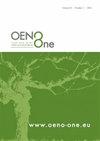多酚从天然和微凝集软木塞向水醇溶液的迁移及其感官影响
IF 2.2
3区 农林科学
Q3 FOOD SCIENCE & TECHNOLOGY
引用次数: 0
摘要
在装瓶陈化过程中,由于瓶子的水平位置,葡萄酒会与软木塞接触。因此,化合物的释放,如软木酚类化合物,发生在软木塞和葡萄酒之间,这取决于软木塞的类型和所应用的表面处理。许多出版物描述了从天然软木塞中提取葡萄酒或水醇溶液中的这些酚类化合物,但很少涉及微凝集软木塞,酿酒师越来越多地使用微凝集软木来密封瓶子。因此,本研究的目的是比较用超临界CO2处理的天然和微凝聚软木塞转移到水醇溶液中的多酚,主要是可水解的单宁。为此,通过HPLC-DAD-ESI-QQQ对天然软木塞和微凝集软木塞的浸渍液中释放的多酚进行了鉴定和定量。亚基酸也进行了定量。在这项研究中,尽管“天然软木塞”内部的变异性很高,但两种类型的软木塞在所有多酚方面都存在显著差异,结块的软木塞释放的多酚明显较少;即减少25倍。相反,木栓酸是以相似的浓度从两种类型的软木塞中提取的;因此,其可提取性不受塞子类型的影响。还对显微组分进行了感官分析。天然软木塞的Macerates带有“纸板、灰尘、木板、木材”和“软木污渍”的痕迹,显著高于超临界CO2处理的微凝聚软木塞浸渍物。此外,多酚含量最高的天然软木浸渍剂比微凝集软木塞更苦。本文章由计算机程序翻译,如有差异,请以英文原文为准。
Migration of polyphenols from natural and microagglomerated cork stoppers to hydroalcoholic solutions and their sensory impact
During bottling aging, the wine comes into contact with the cork stopper due to the horizontal position of the bottle. The release of compounds, such as cork phenolic compounds, thus take place between the cork and the wine, depending on the type of cork stopper and the surface treatments applied. Many publications describe the extraction of these phenolic compounds in wine or hydroalcoholic solutions from natural corks, but few address microagglomerated corks, which are increasingly used by winemakers to seal their bottles. The aim of this study was therefore to compare the polyphenols, mainly hydrolysable tannins, transferred from natural and microagglomerated corks treated with supercritical CO2 into hydroalcoholic solutions. For this purpose, polyphenols released in macerates of natural and microagglomerated cork stoppers were identified and quantified by HPLC-DAD-ESI-QQQ. Suberic acid was also quantified. In this study, despite the high intra-“natural cork stopper” variability, significant differences were found between both types of stoppers for all polyphenols, the agglomerated corks releasing significantly less polyphenols; i.e., 25 times less. In contrast, suberic acid was extracted from both types of corks in similar concentrations; therefore, its extractability was not impacted by the type of stopper. A sensory profile was also carried out on the macerates. Macerates of natural cork stoppers were perceived with notes of “cardboard, dust, plank, wood” and “cork taint” significantly higher than supercritical CO2 treated microagglomerated cork stopper macerates. Moreover, the natural cork macerate with the highest content in polyphenol was perceived as being more bitter than that of microagglomerated cork stoppers.
求助全文
通过发布文献求助,成功后即可免费获取论文全文。
去求助
来源期刊

OENO One
Agricultural and Biological Sciences-Food Science
CiteScore
4.40
自引率
13.80%
发文量
85
审稿时长
13 weeks
期刊介绍:
OENO One is a peer-reviewed journal that publishes original research, reviews, mini-reviews, short communications, perspectives and spotlights in the areas of viticulture, grapevine physiology, genomics and genetics, oenology, winemaking technology and processes, wine chemistry and quality, analytical chemistry, microbiology, sensory and consumer sciences, safety and health. OENO One belongs to the International Viticulture and Enology Society - IVES, an academic association dedicated to viticulture and enology.
 求助内容:
求助内容: 应助结果提醒方式:
应助结果提醒方式:


